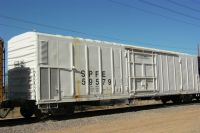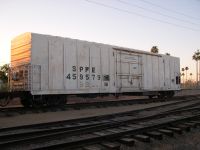SOUTHERN PACIFIC FRUIT EXPRESS
Refrigerator Car No. 459579
|
SOUTHERN PACIFIC FRUIT EXPRESS
Refrigerator Car No. 459579 |
| Listen Here |
Refrigerator cars improved steadily over the years. Besides increasing in size, they changed from ice cooling to mechanical refrigeration. This provided a more dependable environment and eliminated the need to keep cars stocked with ice.
This 60-foot car was built in 1971 with an onboard diesel-powered refrigeration system that could maintain the temperature at just above freezing. It carried perishable fruits and vegetables like oranges, grapefruit, lettuce, potatoes, and melons. These were loaded at docks in Mesa, Higley, Tempe, and Phoenix, and were shipped to markets outside Arizona.
After more than twenty years of service, the Southern Pacific Railroad retired this car in 1995 and donated it to the museum in 1996.
This all-steel reefer was built by Pacific Car & Foundry in May 1971 for Pacific Fruit Express as a model R-70-24. This "60-foot car" was actually 57 feet in length. The mechanical refrigeration compartment was 7 feet long, leaving 50 feet for loading perishables.
The Pacific Fruit Express Company (reporting mark PFE) was founded in 1906 and was jointly owned by the Southern Pacific and Union Pacific railroads. In the 1930s its fleet numbered some 40,000 cars. In 1971, it transferred ownership of the cars to the separate railroads for investment tax purposes, and their reporting marks became SPFE and UPFE. In 1978 the company became a wholly owned subsidiary of the Southern Pacific Railroad, and it was dissolved in 1985.
PFE started painting the cars white in 1981, gave them orange reporting marks in 1983, and eventually changed those to black. In the 1990s, the Southern Pacific round logo was applied to the cars randomly in red, blue, or green colors, then was eventually eliminated.
Mechanical refrigeration units eliminated the large number of personnel required to load ice into thousands of refrigerator cars. A small diesel engine on each car powered an alternator which produced electricity to run the refrigeration equipment. A diesel fuel tank allowed it to keep running for several days before needing refueling.
By the 1970s, refrigerator cars began being replaced by trucks for their greater flexibility. In 1981 they reached their lowest number in service, 8,000 cars. But then rail transport began picking up again, and by 2005 the number had increased to 25,000.
Following its retirement in 1995, this car arrived by rail at the museum's Armstrong Park location on Erie Street in May 1996, then was moved along with the rest of the fleet to the museumís new Tumbleweed Park location in 2006.
 |
11/25/2006 - View of the refrigerator car at Tumbleweed Park. |
 |
2005 - The car at Armstrong Park. |
 |
5/1996 - View of the car as delivered to Armstrong Park. |